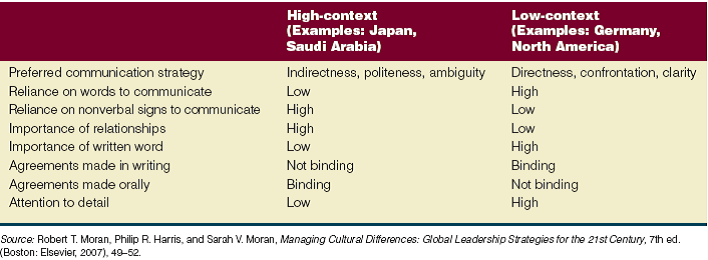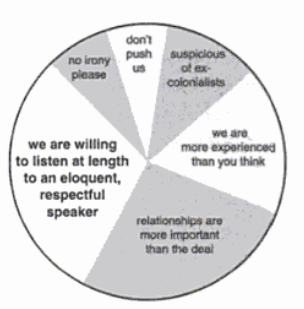Introduction
In the rapidly developing modern world, the process of globalization is the defining factor and the key feature of international relations. Economies, societies, and whole cultures merge and integrate as a result of the ever-growing system of global communication and trade. The decisive role in the process of globalization is played by economic factors: international business, foreign investment, intellectual and technological exchange, — all these components contribute to globalization.
More and more nations are becoming involved into international interaction and are consequently facing the communicational challenges set by the traditional cultural barriers. Misunderstandings emerge within multinational teams since their members are simply unaware of different perceptions and expectations inherent in their foreign colleagues’ philosophy of life and cultural outlook.
When maintaining international business communication it is vital to be aware of the multiple stylistic peculiarities inherent in communicative processes of various nations and cultures. One of the most frequent cultural collisions occurs between the representatives of the East and the West, since they bear diametrically opposite values and communicational standards.
As an example, business communication should be planned especially cautiously between the representatives of India and the USA, since those two nations demonstrate typical instances of high-context culture and low-context culture, with all the ensuing consequences (cf. Fig.1).

Complex Approach to Cultural Differences
Cultural differences have been one of the major issues in research on business communication. Success or failure in international business is defined by the level of partners’ flexibility, openness, and readiness to accept and compromise with each other’s cultural standards. Locker and Kienzler (2008) define a “successful international communicator” as a person who is
“… aware of the values, beliefs, and practices in other cultures; sensitive to differences among individuals within a culture; aware that his or her preferred values and behaviors are influenced by culture and are not necessarily “right”; sensitive to verbal and nonverbal behaviour; flexible and open to change” (p. 432).
Therefore, a complex approach including a whole array of factors is required when investigating the cultural peculiarities of international partners. One of the comprehensive approaches suggested in the research literature is Solomon and Schell’s (2009) scheme comprising seven key characteristics (or “dimensions”) of cross-cultural communication: hierarchy and egalitarianism; group focus; relationships; communication styles; time orientation; change tolerance; and motivation or work-life balance (p. 53).
Consideration for and attention to those dimensions provide the prospective international business partners with the necessary background for successful communication of their cultures. Hereinafter the business cultures of USA and India are compared and contrasted in terms of the characteristics mentioned.
Hierarchy and Egalitarianism
In the organization of the whole society, the principles of hierarchy and egalitarianism play a defining role. Those two approaches to modeling social relations represent antipodes of social perception of power and authority. In hierarchical societies, organizational and social structures are characterized by rigid stratification, which presupposes limited communication between representatives of different strata (Steers at al., 2010, p. 212).
Indian society is an obvious example of such hierarchy, with its caste system quoted not infrequently but actually playing a minor role in business communication (Katz, 2008a, p. 1). What matters more is their attitude to social class as the defining factor in one’s life success or failure, reflecting the Indian reverence to fatalism (Lewis, 2000, p. 341). Transition between social classes is mostly impossible, and therefore one’s family status is the criterion of one’s accomplishments.
Status should be accepted with deference and dignified by appropriate dress and behavior (Solomon and Shell, 2009, pp. 79–80). On the other hand, American society is marked by an unprecedented egalitarianism: everyone is equal and possesses equal opportunities for success. Rags-to-riches stories and tales of self-made men form the Americans strongly egalitarian mindset and result in their relative disregard for initial social stratification (Solomon and Shell, 2009, p. 79).
Relationships and Group Focus
Resulting from the aforementioned cultural standard are the peculiarities of relationships characterizing the two cultures. In the United States, individualism is a very strong tendency in business (Locker and Kienzler, 2008, p. 438).
During negotiations managers tend to take decisions independently of the main office, which could hardly be acceptable in an Indian society (Lewis, 2000, p. 167; Katz, 2008b, p. 3). Indian business is concentrated within a family and works for the whole family interest; family honor is what matters most, and the whole business turns around it (Lewis, 2000, p. 341).
This attitude to one’s business as equaled to one’s extended family is contrasted by the American view of business objective: for them, the main purpose of doing business is making as much profit as possible in the shortest time period (Lewis, 2000, p. 167). Such uncomplicated philosophy of American business aimed at purely materialistic goals entails certain harshness and haste in American way of conducting deals: ‘first come first served’ and ‘time is money’ are the quotes that characterize the US business attitudes best.
Time Orientation
Attitudes to time and ways of handling time issues represent another stumbling block for cross-cultural communication between the Indian and the American businesses. American ‘time is money’ policy results in the high demands for punctuality and fast efficient action within the given time limits.
Being on time and meeting deadlines is a must, since otherwise, the American’s tight schedule would be upset, diminishing the chances for profit. On the contrary, the Indians do not work by the clock, and their notion of time is quite relaxed. This is partially explainable by the religious idea of reincarnation popular in the Indian culture: since everything can reoccur (even if in another life), there is no need to cease the moment immediately (Lewis, 2000, p. 342).
Meetings can be postponed, rescheduled, and held in a relaxed way without pressure for time and speed. If an Indian partner asks to wait for two minutes before he settles another issue, one should not be surprised that those two minutes turn into hours at least. This is yet another example of the Indian view of time, as well as it is an illustration of their way of handling business.
Communication Styles
In general, the Indian business culture operates in the framework of cooperativeness and helpfulness. Therefore, it dictates the rule of saying ‘yes’ to a request even if there is hardly a possibility to fulfil what is asked (Steers et al., 2010, p. 213). Afterwards, the Indian will hold the business up and avoid any direct action or movement till it becomes obvious that the promise will never be kept at all. Unhurriedness characterizes the Indian negotiating style in general.
Respecting the presenter, the Indians are always “ready to listen at length to an eloquent, respectful speaker” (Lewis, 2000, p. 343; cf. Fig. 2). They would start negotiations with a view to long verbose discussions, employing “long, indirect, poetic sentences” and “elegant language” (Locker and Kienzler, 2008, p. 438). Their statements are figural and the florid wording needs to be deciphered for clarity.

This peculiarity of the Indian communication style is totally opposed by the rapid, concrete, and straightforward flow of American speech. Striving to get their deals done as fast as possible, the impatient American businessmen cannot tolerate any lulls or long pauses in the conversation. They discharge a stream of information at their interlocutors and constantly pressure them by inquiring whether they got a deal: first comes the deal, while discussing the details is postponed for later (Lewis, 2000, p. 168).
Recommendations
From all the aforementioned fact it becomes obvious that successful cross-cultural communication between the Indian and the American business partners is endangered by a whole range of cultural discrepancies.
In order to minimize the risks of failure, it is significant to work out compromising strategies that would mitigate the opposition between the cultures and ensure an efficient cooperation between the international teams. Bearing in mind the peculiarities of the Indian business culture, the American managers could undertake the following steps.
Addressing Hierarchy
First, with regard to the importance of hierarchy and group in the Indian society, it would be advisable to organize a solidary and well-knit team of negotiators. Leaving aside the individualistic trends of American management, such team would benefit the overall image of the negotiation process and contribute to the Indian party’s respect for the American company.
The external indication of hierarchical importance should not be neglected either: the generally informal, casual style of American clothing should be changed to a more appropriate outfit that would emphasize the authority and significance of the negotiating team members.
Addressing Family Significance
Second, considering the ultimate significance of family relations for the Indian society, it would be advisable not only to entertain the Indian guests in public places but also to introduce them to the family circle of the American negotiating party.
Family hospitality and generosity make the Indians feel welcome and at ease with the foreign reality, therefore the level of intimacy may be as high as inviting the Indian guests to a personal family party on the occasion of a birthday anniversary or a wedding reception. Otherwise, keeping the Indians out of one’s family may be regarded as disregard and lack of interest in the potential business partner.
Addressing Time Issues
Third, since time perception is diametrically opposite in Indian and American cultures, time issues should be taken care of in advance. A set of agreements about timeliness should be accepted by the parties so that the Indian party is constantly reminded about what exactly should be done in a given period of time.
On the other hand, the schedule should be flexible enough to allow for some lengthy discussions which would let Indian negotiators feel confident of the negotiations success. In this connection, it is also reasonable to be prepared for discussing the details in-depth before concluding the deal.
Addressing Communication Style
Last but not least, bearing in mind the Indian’s tendency to politeness and responsiveness rather than assertiveness and pressure, it is important to recognize that not all the affirmative responses from the Indian party mean the positive outcome of their words. Therefore, a background research should be conducted to ensure that the Indian party can actually fulfill the assumed obligations. Moreover, knowing that oral commitments are more significant to the Indian culture than written ones, it is vital to treat all the verbal agreements with utmost care, in order to avoid future misunderstandings.
Conclusion
As it appears, cross-cultural communication presents a stumbling point for businesses around the world. In case with American and Indian cooperation, the communication process is complicated by a whole set of discrepancies ranging from social perceptions of hierarchy to time orientation. Therefore, various precautionary measures are advisable for the American party to take in order to ensure efficient and successful business negotiation.
References
Katz, L. (2008a) Negotiating international business — India. Web.
Katz, L. (2008b) Negotiating international business — United States. Web.
Lewis, A. D. (2000) When cultures collide: Managing successfully across cultures. 2nd edition. London, Nicholas Brealey Publishing.
Locker, K. O. & Kienzler, D. S. (2008) Business and administrative communication. New York (NY), McGraw Hill / Irwin.
Solomon, C. & Schell, M. S. (2009) Managing across cultures: The 7 keys to doing business with a global mindset. Hightstown (NJ), McGraw Hill Education.
Steers, R. M., Sanchez-Runde, C. & Nardon, L. (2010) Management across cultures: Challenges and strategies. New York (NY), Cambridge University Press.